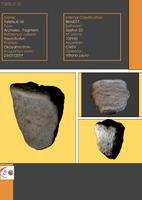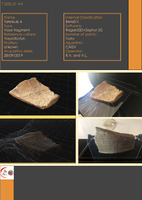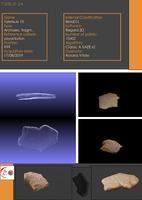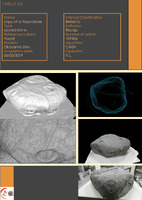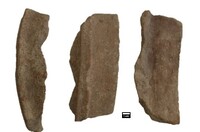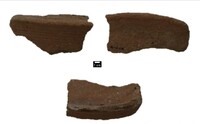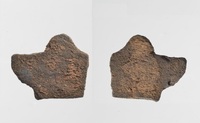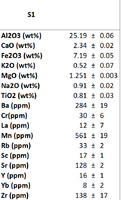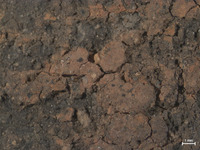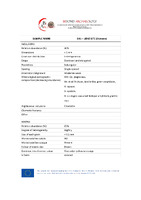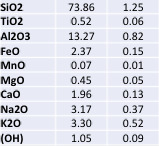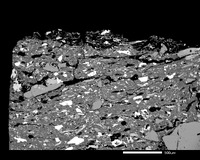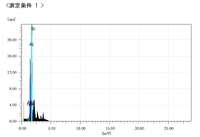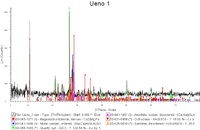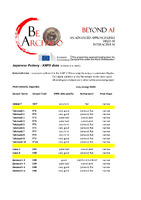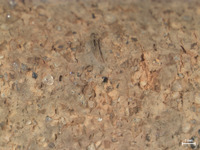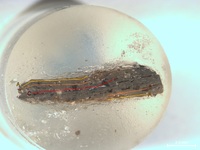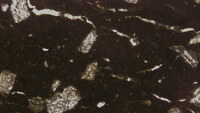Search
2073 items
-
AF TTK 055
Carved stone object with interlocking designs from the Tatetsuki burial mound in Okayama Prefecture -
AF TTK 101 OM Data interpretation
Micromorphology of the surface of ceramic shard. -
AF TTK 101 XRF processing and modelling
XRF quantitative analysis processed by Olympus Vanta software. "Name" is referred to the shard code with a progressive number indicating different measurements spots. "Note" shows the location of measurement spots. The values of the elements are expressed as a percentage by weight. "LE" means light elements i.e. the amount of elements not detectable (Tatetsuki pottery Vanta chemistry XRF results.xlsx).
XRF quantitative analysis processed by Olympus Vanta software converted into oxides: SiO2, Al2O3, Fe2O3, CaO, MgO, K2O and TiO2. The conversion to oxides is obtained by multiplying the weight concentration of the element by a conversion factor derived from the ratio of molecular weight of the chosen oxide divided by the atomic weight of the elements. (Tatetsuki pottery Vanta chemistry XRF oxides results.xlsx). -
AF TTK 102 XRF processing and modelling
XRF quantitative analysis processed by Olympus Vanta software. "Name" is referred to the shard code with a progressive number indicating different measurements spots. "Note" shows the location of measurement spots. The values of the elements are expressed as a percentage by weight. "LE" means light elements i.e. the amount of elements not detectable (Tatetsuki pottery Vanta chemistry XRF results.xlsx).
XRF quantitative analysis processed by Olympus Vanta software converted into oxides: SiO2, Al2O3, Fe2O3, CaO, MgO, K2O and TiO2. The conversion to oxides is obtained by multiplying the weight concentration of the element by a conversion factor derived from the ratio of molecular weight of the chosen oxide divided by the atomic weight of the elements. (Tatetsuki pottery Vanta chemistry XRF oxides results.xlsx). -
AF TTK 103 XRF processing and modelling
XRF quantitative analysis processed by Olympus Vanta software. "Name" is referred to the shard code with a progressive number indicating different measurements spots. "Note" shows the location of measurement spots. The values of the elements are expressed as a percentage by weight. "LE" means light elements i.e. the amount of elements not detectable (Tatetsuki pottery Vanta chemistry XRF results.xlsx).
XRF quantitative analysis processed by Olympus Vanta software converted into oxides: SiO2, Al2O3, Fe2O3, CaO, MgO, K2O and TiO2. The conversion to oxides is obtained by multiplying the weight concentration of the element by a conversion factor derived from the ratio of molecular weight of the chosen oxide divided by the atomic weight of the elements. (Tatetsuki pottery Vanta chemistry XRF oxides results.xlsx). -
AF TTK 104 XRF processing and modelling
XRF quantitative analysis processed by Olympus Vanta software. "Name" is referred to the shard code with a progressive number indicating different measurements spots. "Note" shows the location of measurement spots. The values of the elements are expressed as a percentage by weight. "LE" means light elements i.e. the amount of elements not detectable (Tatetsuki pottery Vanta chemistry XRF results.xlsx).
XRF quantitative analysis processed by Olympus Vanta software converted into oxides: SiO2, Al2O3, Fe2O3, CaO, MgO, K2O and TiO2. The conversion to oxides is obtained by multiplying the weight concentration of the element by a conversion factor derived from the ratio of molecular weight of the chosen oxide divided by the atomic weight of the elements. (Tatetsuki pottery Vanta chemistry XRF oxides results.xlsx). -
AF TTK 105 XRF processing and modelling
XRF quantitative analysis processed by Olympus Vanta software. "Name" is referred to the shard code with a progressive number indicating different measurements spots. "Note" shows the location of measurement spots. The values of the elements are expressed as a percentage by weight. "LE" means light elements i.e. the amount of elements not detectable (Tatetsuki pottery Vanta chemistry XRF results.xlsx).
XRF quantitative analysis processed by Olympus Vanta software converted into oxides: SiO2, Al2O3, Fe2O3, CaO, MgO, K2O and TiO2. The conversion to oxides is obtained by multiplying the weight concentration of the element by a conversion factor derived from the ratio of molecular weight of the chosen oxide divided by the atomic weight of the elements. (Tatetsuki pottery Vanta chemistry XRF oxides results.xlsx). -
AF TTK 106 XRF processing and modelling
XRF quantitative analysis processed by Olympus Vanta software. "Name" is referred to the shard code with a progressive number indicating different measurements spots. "Note" shows the location of measurement spots. The values of the elements are expressed as a percentage by weight. "LE" means light elements i.e. the amount of elements not detectable (Tatetsuki pottery Vanta chemistry XRF results.xlsx).
XRF quantitative analysis processed by Olympus Vanta software converted into oxides: SiO2, Al2O3, Fe2O3, CaO, MgO, K2O and TiO2. The conversion to oxides is obtained by multiplying the weight concentration of the element by a conversion factor derived from the ratio of molecular weight of the chosen oxide divided by the atomic weight of the elements. (Tatetsuki pottery Vanta chemistry XRF oxides results.xlsx). -
AF TTK 107 OM processing and modeling
Incisions description (parallel, curved and even impressions).
Inclusions characterization (color, shape and size).
Cross section characterization (in case of visible layers). -
AF TTK 107 XRF processing and modelling
XRF quantitative analysis processed by Olympus Vanta software. "Name" is referred to the shard code with a progressive number indicating different measurements spots. "Note" shows the location of measurement spots. The values of the elements are expressed as a percentage by weight. "LE" means light elements i.e. the amount of elements not detectable (Tatetsuki pottery Vanta chemistry XRF results.xlsx).
XRF quantitative analysis processed by Olympus Vanta software converted into oxides: SiO2, Al2O3, Fe2O3, CaO, MgO, K2O and TiO2. The conversion to oxides is obtained by multiplying the weight concentration of the element by a conversion factor derived from the ratio of molecular weight of the chosen oxide divided by the atomic weight of the elements. (Tatetsuki pottery Vanta chemistry XRF oxides results.xlsx). -
AF TTK 108 OM processing and modeling
Incisions description (parallel, curved and even impressions).
Inclusions characterization (color, shape and size).
Cross section characterization (in case of visible layers). -
AF TTK 108 XRF processing and modelling
XRF quantitative analysis processed by Olympus Vanta software. "Name" is referred to the shard code with a progressive number indicating different measurements spots. "Note" shows the location of measurement spots. The values of the elements are expressed as a percentage by weight. "LE" means light elements i.e. the amount of elements not detectable (Tatetsuki pottery Vanta chemistry XRF results.xlsx).
XRF quantitative analysis processed by Olympus Vanta software converted into oxides: SiO2, Al2O3, Fe2O3, CaO, MgO, K2O and TiO2. The conversion to oxides is obtained by multiplying the weight concentration of the element by a conversion factor derived from the ratio of molecular weight of the chosen oxide divided by the atomic weight of the elements. (Tatetsuki pottery Vanta chemistry XRF oxides results.xlsx). -
AF TTK 109 OM processing and modeling
Incisions description (parallel, curved and even impressions).
Inclusions characterization (color, shape and size).
Cross section characterization (in case of visible layers). -
AF TTK 109 XRF processing and modelling
XRF quantitative analysis processed by Olympus Vanta software. "Name" is referred to the shard code with a progressive number indicating different measurements spots. "Note" shows the location of measurement spots. The values of the elements are expressed as a percentage by weight. "LE" means light elements i.e. the amount of elements not detectable (Tatetsuki pottery Vanta chemistry XRF results.xlsx).
XRF quantitative analysis processed by Olympus Vanta software converted into oxides: SiO2, Al2O3, Fe2O3, CaO, MgO, K2O and TiO2. The conversion to oxides is obtained by multiplying the weight concentration of the element by a conversion factor derived from the ratio of molecular weight of the chosen oxide divided by the atomic weight of the elements. (Tatetsuki pottery Vanta chemistry XRF oxides results.xlsx). -
AF TTK 110 OM processing and modeling
Incisions description (parallel, curved and even impressions).
Inclusions characterization (color, shape and size).
Cross section characterization (in case of visible layers). -
AF TTK 110 XRF processing and modelling
XRF quantitative analysis processed by Olympus Vanta software. "Name" is referred to the shard code with a progressive number indicating different measurements spots. "Note" shows the location of measurement spots. The values of the elements are expressed as a percentage by weight. "LE" means light elements i.e. the amount of elements not detectable (Tatetsuki pottery Vanta chemistry XRF results.xlsx).
XRF quantitative analysis processed by Olympus Vanta software converted into oxides: SiO2, Al2O3, Fe2O3, CaO, MgO, K2O and TiO2. The conversion to oxides is obtained by multiplying the weight concentration of the element by a conversion factor derived from the ratio of molecular weight of the chosen oxide divided by the atomic weight of the elements. (Tatetsuki pottery Vanta chemistry XRF oxides results.xlsx). -
AF TTK 111 OM processing and modeling
Incisions description (parallel, curved and even impressions).
Inclusions characterization (color, shape and size).
Cross section characterization (in case of visible layers). -
AF TTK 111 XRF processing and modelling
XRF quantitative analysis processed by Olympus Vanta software. "Name" is referred to the shard code with a progressive number indicating different measurements spots. "Note" shows the location of measurement spots. The values of the elements are expressed as a percentage by weight. "LE" means light elements i.e. the amount of elements not detectable (Tatetsuki pottery Vanta chemistry XRF results.xlsx).
XRF quantitative analysis processed by Olympus Vanta software converted into oxides: SiO2, Al2O3, Fe2O3, CaO, MgO, K2O and TiO2. The conversion to oxides is obtained by multiplying the weight concentration of the element by a conversion factor derived from the ratio of molecular weight of the chosen oxide divided by the atomic weight of the elements. (Tatetsuki pottery Vanta chemistry XRF oxides results.xlsx). -
AF TTK 112 OM processing and modeling
Incisions description (parallel, curved and even impressions).
Inclusions characterization (color, shape and size).
Cross section characterization (in case of visible layers). -
AF TTK 112 XRF processing and modelling
XRF quantitative analysis processed by Olympus Vanta software. "Name" is referred to the shard code with a progressive number indicating different measurements spots. "Note" shows the location of measurement spots. The values of the elements are expressed as a percentage by weight. "LE" means light elements i.e. the amount of elements not detectable (Tatetsuki pottery Vanta chemistry XRF results.xlsx).
XRF quantitative analysis processed by Olympus Vanta software converted into oxides: SiO2, Al2O3, Fe2O3, CaO, MgO, K2O and TiO2. The conversion to oxides is obtained by multiplying the weight concentration of the element by a conversion factor derived from the ratio of molecular weight of the chosen oxide divided by the atomic weight of the elements. (Tatetsuki pottery Vanta chemistry XRF oxides results.xlsx). -
AF TTK 113 OM processing and modeling
Incisions description (parallel, curved and even impressions).
Inclusions characterization (color, shape and size).
Cross section characterization (in case of visible layers). -
AF TTK 113 XRF processing and modelling
XRF quantitative analysis processed by Olympus Vanta software. "Name" is referred to the shard code with a progressive number indicating different measurements spots. "Note" shows the location of measurement spots. The values of the elements are expressed as a percentage by weight. "LE" means light elements i.e. the amount of elements not detectable (Tatetsuki pottery Vanta chemistry XRF results.xlsx).
XRF quantitative analysis processed by Olympus Vanta software converted into oxides: SiO2, Al2O3, Fe2O3, CaO, MgO, K2O and TiO2. The conversion to oxides is obtained by multiplying the weight concentration of the element by a conversion factor derived from the ratio of molecular weight of the chosen oxide divided by the atomic weight of the elements. (Tatetsuki pottery Vanta chemistry XRF oxides results.xlsx). -
AF TTK 114 OM processing and modeling
Incisions description (parallel, curved and even impressions).
Inclusions characterization (color, shape and size).
Cross section characterization (in case of visible layers). -
AF TTK 114 XRF processing and modelling
XRF quantitative analysis processed by Olympus Vanta software. "Name" is referred to the shard code with a progressive number indicating different measurements spots. "Note" shows the location of measurement spots. The values of the elements are expressed as a percentage by weight. "LE" means light elements i.e. the amount of elements not detectable (Tatetsuki pottery Vanta chemistry XRF results.xlsx).
XRF quantitative analysis processed by Olympus Vanta software converted into oxides: SiO2, Al2O3, Fe2O3, CaO, MgO, K2O and TiO2. The conversion to oxides is obtained by multiplying the weight concentration of the element by a conversion factor derived from the ratio of molecular weight of the chosen oxide divided by the atomic weight of the elements. (Tatetsuki pottery Vanta chemistry XRF oxides results.xlsx). -
AF TTK 115 OM processing and modeling
Incisions description (parallel, curved and even impressions).
Inclusions characterization (color, shape and size).
Cross section characterization (in case of visible layers). -
AF TTK 115 XRF processing and modelling
XRF quantitative analysis processed by Olympus Vanta software. "Name" is referred to the shard code with a progressive number indicating different measurements spots. "Note" shows the location of measurement spots. The values of the elements are expressed as a percentage by weight. "LE" means light elements i.e. the amount of elements not detectable (Tatetsuki pottery Vanta chemistry XRF results.xlsx).
XRF quantitative analysis processed by Olympus Vanta software converted into oxides: SiO2, Al2O3, Fe2O3, CaO, MgO, K2O and TiO2. The conversion to oxides is obtained by multiplying the weight concentration of the element by a conversion factor derived from the ratio of molecular weight of the chosen oxide divided by the atomic weight of the elements. (Tatetsuki pottery Vanta chemistry XRF oxides results.xlsx). -
AF TTK 116 OM processing and modeling
Incisions description (parallel, curved and even impressions).
Inclusions characterization (color, shape and size).
Cross section characterization (in case of visible layers). -
AF TTK 116 XRF processing and modelling
XRF quantitative analysis processed by Olympus Vanta software. "Name" is referred to the shard code with a progressive number indicating different measurements spots. "Note" shows the location of measurement spots. The values of the elements are expressed as a percentage by weight. "LE" means light elements i.e. the amount of elements not detectable (Tatetsuki pottery Vanta chemistry XRF results.xlsx).
XRF quantitative analysis processed by Olympus Vanta software converted into oxides: SiO2, Al2O3, Fe2O3, CaO, MgO, K2O and TiO2. The conversion to oxides is obtained by multiplying the weight concentration of the element by a conversion factor derived from the ratio of molecular weight of the chosen oxide divided by the atomic weight of the elements. (Tatetsuki pottery Vanta chemistry XRF oxides results.xlsx). -
AF TTK 117 OM processing and modeling
Incisions description (parallel, curved and even impressions).
Inclusions characterization (color, shape and size).
Cross section characterization (in case of visible layers). -
AF TTK 117 XRF processing and modelling
XRF quantitative analysis processed by Olympus Vanta software. "Name" is referred to the shard code with a progressive number indicating different measurements spots. "Note" shows the location of measurement spots. The values of the elements are expressed as a percentage by weight. "LE" means light elements i.e. the amount of elements not detectable (Tatetsuki pottery Vanta chemistry XRF results.xlsx).
XRF quantitative analysis processed by Olympus Vanta software converted into oxides: SiO2, Al2O3, Fe2O3, CaO, MgO, K2O and TiO2. The conversion to oxides is obtained by multiplying the weight concentration of the element by a conversion factor derived from the ratio of molecular weight of the chosen oxide divided by the atomic weight of the elements. (Tatetsuki pottery Vanta chemistry XRF oxides results.xlsx). -
AF TTK 118 OM processing and modeling
Incisions description (parallel, curved and even impressions).
Inclusions characterization (color, shape and size).
Cross section characterization (in case of visible layers). -
AF TTK 118 XRF processing and modelling
XRF quantitative analysis processed by Olympus Vanta software. "Name" is referred to the shard code with a progressive number indicating different measurements spots. "Note" shows the location of measurement spots. The values of the elements are expressed as a percentage by weight. "LE" means light elements i.e. the amount of elements not detectable (Tatetsuki pottery Vanta chemistry XRF results.xlsx).
XRF quantitative analysis processed by Olympus Vanta software converted into oxides: SiO2, Al2O3, Fe2O3, CaO, MgO, K2O and TiO2. The conversion to oxides is obtained by multiplying the weight concentration of the element by a conversion factor derived from the ratio of molecular weight of the chosen oxide divided by the atomic weight of the elements. (Tatetsuki pottery Vanta chemistry XRF oxides results.xlsx). -
AF TTK 119 OM processing and modeling
Incisions description (parallel, curved and even impressions).
Inclusions characterization (color, shape and size).
Cross section characterization (in case of visible layers). -
AF TTK 119 XRF processing and modelling
XRF quantitative analysis processed by Olympus Vanta software. "Name" is referred to the shard code with a progressive number indicating different measurements spots. "Note" shows the location of measurement spots. The values of the elements are expressed as a percentage by weight. "LE" means light elements i.e. the amount of elements not detectable (Tatetsuki pottery Vanta chemistry XRF results.xlsx).
XRF quantitative analysis processed by Olympus Vanta software converted into oxides: SiO2, Al2O3, Fe2O3, CaO, MgO, K2O and TiO2. The conversion to oxides is obtained by multiplying the weight concentration of the element by a conversion factor derived from the ratio of molecular weight of the chosen oxide divided by the atomic weight of the elements. (Tatetsuki pottery Vanta chemistry XRF oxides results.xlsx). -
AF TTK 120 OM processing and modeling
Incisions description (parallel, curved and even impressions).
Inclusions characterization (color, shape and size).
Cross section characterization (in case of visible layers). -
AF TTK 120 XRF processing and modelling
XRF quantitative analysis processed by Olympus Vanta software. "Name" is referred to the shard code with a progressive number indicating different measurements spots. "Note" shows the location of measurement spots. The values of the elements are expressed as a percentage by weight. "LE" means light elements i.e. the amount of elements not detectable (Tatetsuki pottery Vanta chemistry XRF results.xlsx).
XRF quantitative analysis processed by Olympus Vanta software converted into oxides: SiO2, Al2O3, Fe2O3, CaO, MgO, K2O and TiO2. The conversion to oxides is obtained by multiplying the weight concentration of the element by a conversion factor derived from the ratio of molecular weight of the chosen oxide divided by the atomic weight of the elements. (Tatetsuki pottery Vanta chemistry XRF oxides results.xlsx). -
AF TTK 121 OM processing and modeling
Incisions description (parallel, curved and even impressions).
Inclusions characterization (color, shape and size).
Cross section characterization (in case of visible layers). -
AF TTK 121 XRF processing and modelling
XRF quantitative analysis processed by Olympus Vanta software. "Name" is referred to the shard code with a progressive number indicating different measurements spots. "Note" shows the location of measurement spots. The values of the elements are expressed as a percentage by weight. "LE" means light elements i.e. the amount of elements not detectable (Tatetsuki pottery Vanta chemistry XRF results.xlsx).
XRF quantitative analysis processed by Olympus Vanta software converted into oxides: SiO2, Al2O3, Fe2O3, CaO, MgO, K2O and TiO2. The conversion to oxides is obtained by multiplying the weight concentration of the element by a conversion factor derived from the ratio of molecular weight of the chosen oxide divided by the atomic weight of the elements. (Tatetsuki pottery Vanta chemistry XRF oxides results.xlsx). -
AF TTK 122 OM processing and modeling
Incisions description (parallel, curved and even impressions).
Inclusions characterization (color, shape and size).
Cross section characterization (in case of visible layers). -
AF TTK 122 XRF processing and modelling
XRF quantitative analysis processed by Olympus Vanta software. "Name" is referred to the shard code with a progressive number indicating different measurements spots. "Note" shows the location of measurement spots. The values of the elements are expressed as a percentage by weight. "LE" means light elements i.e. the amount of elements not detectable (Tatetsuki pottery Vanta chemistry XRF results.xlsx).
XRF quantitative analysis processed by Olympus Vanta software converted into oxides: SiO2, Al2O3, Fe2O3, CaO, MgO, K2O and TiO2. The conversion to oxides is obtained by multiplying the weight concentration of the element by a conversion factor derived from the ratio of molecular weight of the chosen oxide divided by the atomic weight of the elements. (Tatetsuki pottery Vanta chemistry XRF oxides results.xlsx). -
AF TTK 123 OM processing and modeling
Incisions description (parallel, curved and even impressions).
Inclusions characterization (color, shape and size).
Cross section characterization (in case of visible layers). -
AF TTK 123 XRF processing and modelling
XRF quantitative analysis processed by Olympus Vanta software. "Name" is referred to the shard code with a progressive number indicating different measurements spots. "Note" shows the location of measurement spots. The values of the elements are expressed as a percentage by weight. "LE" means light elements i.e. the amount of elements not detectable (Tatetsuki pottery Vanta chemistry XRF results.xlsx).
XRF quantitative analysis processed by Olympus Vanta software converted into oxides: SiO2, Al2O3, Fe2O3, CaO, MgO, K2O and TiO2. The conversion to oxides is obtained by multiplying the weight concentration of the element by a conversion factor derived from the ratio of molecular weight of the chosen oxide divided by the atomic weight of the elements. (Tatetsuki pottery Vanta chemistry XRF oxides results.xlsx). -
AF TTK 124 OM processing and modeling
Incisions description (parallel, curved and even impressions).
Inclusions characterization (color, shape and size).
Cross section characterization (in case of visible layers). -
AF TTK 124 XRF processing and modelling
XRF quantitative analysis processed by Olympus Vanta software. "Name" is referred to the shard code with a progressive number indicating different measurements spots. "Note" shows the location of measurement spots. The values of the elements are expressed as a percentage by weight. "LE" means light elements i.e. the amount of elements not detectable (Tatetsuki pottery Vanta chemistry XRF results.xlsx).
XRF quantitative analysis processed by Olympus Vanta software converted into oxides: SiO2, Al2O3, Fe2O3, CaO, MgO, K2O and TiO2. The conversion to oxides is obtained by multiplying the weight concentration of the element by a conversion factor derived from the ratio of molecular weight of the chosen oxide divided by the atomic weight of the elements. (Tatetsuki pottery Vanta chemistry XRF oxides results.xlsx). -
AF TTK 125 OM processing and modeling
Incisions description (parallel, curved and even impressions).
Inclusions characterization (color, shape and size).
Cross section characterization (in case of visible layers). -
AF TTK 125 XRF processing and modelling
XRF quantitative analysis processed by Olympus Vanta software. "Name" is referred to the shard code with a progressive number indicating different measurements spots. "Note" shows the location of measurement spots. The values of the elements are expressed as a percentage by weight. "LE" means light elements i.e. the amount of elements not detectable (Tatetsuki pottery Vanta chemistry XRF results.xlsx).
XRF quantitative analysis processed by Olympus Vanta software converted into oxides: SiO2, Al2O3, Fe2O3, CaO, MgO, K2O and TiO2. The conversion to oxides is obtained by multiplying the weight concentration of the element by a conversion factor derived from the ratio of molecular weight of the chosen oxide divided by the atomic weight of the elements. (Tatetsuki pottery Vanta chemistry XRF oxides results.xlsx). -
AF TTK 126 OM processing and modeling
Incisions description (parallel, curved and even impressions).
Inclusions characterization (color, shape and size).
Cross section characterization (in case of visible layers). -
AF TTK 126 XRF processing and modelling
XRF quantitative analysis processed by Olympus Vanta software. "Name" is referred to the shard code with a progressive number indicating different measurements spots. "Note" shows the location of measurement spots. The values of the elements are expressed as a percentage by weight. "LE" means light elements i.e. the amount of elements not detectable (Tatetsuki pottery Vanta chemistry XRF results.xlsx).
XRF quantitative analysis processed by Olympus Vanta software converted into oxides: SiO2, Al2O3, Fe2O3, CaO, MgO, K2O and TiO2. The conversion to oxides is obtained by multiplying the weight concentration of the element by a conversion factor derived from the ratio of molecular weight of the chosen oxide divided by the atomic weight of the elements. (Tatetsuki pottery Vanta chemistry XRF oxides results.xlsx). -
AF TTK 127 OM processing and modeling
Incisions description (parallel, curved and even impressions).
Inclusions characterization (color, shape and size).
Cross section characterization (in case of visible layers). -
AF TTK 127 XRF processing and modelling
XRF quantitative analysis processed by Olympus Vanta software. "Name" is referred to the shard code with a progressive number indicating different measurements spots. "Note" shows the location of measurement spots. The values of the elements are expressed as a percentage by weight. "LE" means light elements i.e. the amount of elements not detectable (Tatetsuki pottery Vanta chemistry XRF results.xlsx).
XRF quantitative analysis processed by Olympus Vanta software converted into oxides: SiO2, Al2O3, Fe2O3, CaO, MgO, K2O and TiO2. The conversion to oxides is obtained by multiplying the weight concentration of the element by a conversion factor derived from the ratio of molecular weight of the chosen oxide divided by the atomic weight of the elements. (Tatetsuki pottery Vanta chemistry XRF oxides results.xlsx). -
AF TTK 128 OM processing and modeling
Incisions description (parallel, curved and even impressions).
Inclusions characterization (color, shape and size).
Cross section characterization (in case of visible layers). -
AF TTK 128 XRF processing and modelling
XRF quantitative analysis processed by Olympus Vanta software. "Name" is referred to the shard code with a progressive number indicating different measurements spots. "Note" shows the location of measurement spots. The values of the elements are expressed as a percentage by weight. "LE" means light elements i.e. the amount of elements not detectable (Tatetsuki pottery Vanta chemistry XRF results.xlsx).
XRF quantitative analysis processed by Olympus Vanta software converted into oxides: SiO2, Al2O3, Fe2O3, CaO, MgO, K2O and TiO2. The conversion to oxides is obtained by multiplying the weight concentration of the element by a conversion factor derived from the ratio of molecular weight of the chosen oxide divided by the atomic weight of the elements. (Tatetsuki pottery Vanta chemistry XRF oxides results.xlsx). -
AF TTK 129 OM processing and modeling
Incisions description (parallel, curved and even impressions).
Inclusions characterization (color, shape and size).
Cross section characterization (in case of visible layers). -
AF TTK 129 XRF processing and modelling
XRF quantitative analysis processed by Olympus Vanta software. "Name" is referred to the shard code with a progressive number indicating different measurements spots. "Note" shows the location of measurement spots. The values of the elements are expressed as a percentage by weight. "LE" means light elements i.e. the amount of elements not detectable (Tatetsuki pottery Vanta chemistry XRF results.xlsx).
XRF quantitative analysis processed by Olympus Vanta software converted into oxides: SiO2, Al2O3, Fe2O3, CaO, MgO, K2O and TiO2. The conversion to oxides is obtained by multiplying the weight concentration of the element by a conversion factor derived from the ratio of molecular weight of the chosen oxide divided by the atomic weight of the elements. (Tatetsuki pottery Vanta chemistry XRF oxides results.xlsx). -
AF TTK 130 OM processing and modeling
Incisions description (parallel, curved and even impressions).
Inclusions characterization (color, shape and size).
Cross section characterization (in case of visible layers). -
AF TTK 130 XRF processing and modelling
XRF quantitative analysis processed by Olympus Vanta software. "Name" is referred to the shard code with a progressive number indicating different measurements spots. "Note" shows the location of measurement spots. The values of the elements are expressed as a percentage by weight. "LE" means light elements i.e. the amount of elements not detectable (Tatetsuki pottery Vanta chemistry XRF results.xlsx).
XRF quantitative analysis processed by Olympus Vanta software converted into oxides: SiO2, Al2O3, Fe2O3, CaO, MgO, K2O and TiO2. The conversion to oxides is obtained by multiplying the weight concentration of the element by a conversion factor derived from the ratio of molecular weight of the chosen oxide divided by the atomic weight of the elements. (Tatetsuki pottery Vanta chemistry XRF oxides results.xlsx). -
AF TTK 131
Yayoi pottery - shard of foot from Tokusyu-Kidai (large ceremonial pot stands), from Tatetski archaeological site. -
AF TTK 132
Yayoi pottery - shard from a jar rim from Tatetski archaeological site. -
AF TTK 133
Yayoi pottery - shard from a jar neck from Tatetski archaeological site. -
AF UEN 001
Yayoi pottery - shard of Tokusyu-Tsubo (large ceremonial vessel/jar) from Ueno 1 (Shimane) archaeological site. -
AF UEN 001 ICP-OES acquisition
Procedures for measurements and raw data. -
AF UEN 001 ICP-OES interpretation_1
Classification of clay body according to Ca and Mg concentration. -
AF UEN 001 ICP-OES interpretation_2
Composition of AF UEN 001 determined by ICP-OES compared with the one of other coheval fragments found in Kibi and Izumo areas. -
AF UEN 001 ICP-OES processing and modeling
Quantitative elemental composition for major, minor and trace elements -
AF UEN 001 OM acquisition
Optical microscopy (stereomicroscopy) on surface and reflected light microscopy on polished cross sections of ceramic sample AF UEN 001. -
AF UEN 001 OM for SEM acquisition
Optical microphotogrametry specifying areas for areas analysed by Scanning Electron Microscopy with Energy Dispersive X-ray. -
AF UEN 001 OM interpretation_1
Micromorphology of the surface of ceramic shard. -
AF UEN 001 OM interpretation_2
Micromorphology of AF UEN 001 cross-section compared with those of fragments with similar elemental composition determined by ICP-OES. -
AF UEN 001 OM processing and modeling
Incisions description (parallel, curved and even impressions).
Inclusions characterization (color, shape and size).
Cross section characterization (in case of visible layers). -
AF UEN 001 PLM acquisition
Photomicrographs acquired at different magnifications. -
AF UEN 001 PLM Data interpretation
Micromorphology of thin section from AF UEN 001. -
AF UEN 001 PLM processing and modeling
Petrographic examination -
AF UEN 001 SEM Accuracy Value table
AF UEN 001 SEM Accuracy Value table -
AF UEN 001 SEM EDX acquisition
Elemental chemical composition acquired by Scanning Electron Microscopy with Energy Dispersive X-ray analysis. -
AF UEN 001 SEM EDX processing and modeling
Elemental examination of AF UEN 001 cross section. -
AF UEN 001 SEM images acquisition
Backscattered Images acquired by Scanning Electron Microscopy at 50x and 200x magnification.
Images along the surface from left to right from 1 to 6 at 50x; 7 to 16 at 200x; Images also under 17 to 19 at 50x -
AF UEN 001 XRF acquisition
Chemical analysis of pottery shard by X-Ray Fluorescence Spectroscopy -
AF UEN 001 XRF processing and modeling
Elemental analysis of AF UEN 001. -
AF UEN 001 XRPD acquisition
X-ray Powder Diffraction analysis on sample AF UEN 001. -
AF UEN 001 XRPD processing and modeling
Mineralogical analysis. -
AF UEN 002
Yayoi pottery - Tokusyu-Tsubo(large ceremonial vessel/jar) from Ueno 2 (Shimane) archaeological site. -
AF UEN 002 ICP-OES acquisition
Procedures for measurements and raw data. -
AF UEN 002 ICP-OES Data Interpretation_1
Classification of clay body according to Ca and Mg concentration -
AF UEN 002 ICP-OES processing and modeling
Quantitative elemental composition for major, minor and trace elements. -
AF UEN 002 OM acquisition
Optical microscopy (stereomicroscopy) on surface and reflected light microscopy on polished cross sections of ceramic sample AF UEN 002. -
AF UEN 002 OM for SEM acquisition
Optical microphotogrametry specifying areas for SEM images and areas analysed by Scanning Electron Microscopy with Energy Dispersive X-ray. -
AF UEN 002 OM processing and modeling
Incisions description (parallel, curved and even impressions).
Inclusions characterization (color, shape and size).
Cross section characterization (in case of visible layers). -
AF UEN 002 PLM acquisition
Photomicrographs acquired at different magnifications -
AF UEN 002 PLM Data interpretation
Micromorphology of thin section from AF UEN 002


